Spy in the Sky! Civilian Drone Flew Undected Over U.S. Aircraft Carrier in Japan
Recent incidents involving suspected unauthorized drone flights over key naval assets in Yokosuka, Japan, have raised security concerns. Imagery of the U.S. Navy's USS Ronald Reagan and Japan's JS Izumo appeared on social media, reportedly captured by a civilian drone, highlighting potential vulnerabilities.
Summary: Recent incidents involving suspected unauthorized drone flights over key naval assets in Yokosuka, Japan, have raised security concerns. Imagery of the U.S. Navy's USS Ronald Reagan and Japan's JS Izumo appeared on social media, reportedly captured by a civilian drone, highlighting potential vulnerabilities.

-While no damage occurred, the incident underscores the risk of drones being used for more than surveillance, possibly even for attacks similar to those seen in Ukraine.
-Both U.S. and Japanese defense officials are investigating, emphasizing the importance of enhancing security measures around military facilities to mitigate the threat of drones, which could cause significant damage even to major warships.
Naval Base Security Under Scrutiny After Drone Flies Over USS Ronald Reagan
It is common for the U.S. Navy to release images of its warships on social media, but the sea service wasn’t too pleased as imagery circulated of the Nimitz-class nuclear-powered supercarrier USS Ronald Reagan (CVN-76) in port at Yokosuka, Japan. According to reports, a civilian drone may have flown directly over the aircraft carrier's flight deck last month and wasn't detected.
Exactly when the incident occurred is unclear, but the aerial photos and videos were first posted to X, the social media platform formerly known as Twitter, on April 4. Four photos show the carrier, the amphibious command ship USS Blue Ridge, and multiple destroyers—as well as much of the base's port facilities.
The U.S. Navy has not confirmed that a civilian drone was involved, but there is speculation a Chinese citizen recorded the video.
Japanese Warships Also Recorded
Another Chinese drone was suspected of recording the Japanese Maritime Self-Defense Force's (JMSDF's) JS Izumo, a helicopter carrier currently being modified to operate as an aircraft carrier with the short/vertical takeoff and landing F-35B Lightning II multirole fighter. Video of the Japanese flattop—also recorded at the JMSDF Yokosuka Base in Kanagawa Prefecture south of Tokyo—has also made the rounds on Chinese social media platforms. The base is home to the United States Navy’s Seventh Fleet.

According to a report from The Diplomat, flying a drone over SDF-related facilities and their surrounding areas such as the Yokosuka base is prohibited by law. Drone flights are also restricted above key public and diplomatic areas as well as nuclear power facilities. Those who violate the law are subject to imprisonment for up to one year or a fine of up to 500,000 yen ($3,300).
In 2015, a small drone laced with traces of radiation was found on the roof of the prime minister's office, sparking concerns about drones and their possible use for terrorist attacks, the Associated Press reported. There were no injuries or damage from that incident, but its owner was convicted of obstruction of business.
“We are analyzing the video, including the possibility that it was processed or fabricated with malicious intent,” Japanese defense minister Kihara Minoru said at a press conference last month.
“We strictly monitor [drone activities around the Yokosuka base] on a regular basis,” he added. “We will continue to work closely with related organizations to ensure base security.”
Attack of the Drones
The concern is that the next incident might not just be a drone filming a warship or facilities—but could be employed to seriously damage the vessel or the aircraft on the flight deck.
Ports are generally believed to be safe locations, but as noted by the bombing of the Arleigh Burke-class guided-missile destroyer USS Cole (DDG-67) while in port in Aden harbor in Yemen, that isn't always the case. Seventeen U.S. Navy sailors were killed, and thirty-seven injured. It was the deadliest attack against a U.S. Navy vessel since the USS Stark (FFG-31) incident in 1987.

As has been seen in the fighting in Ukraine, small commercial “off-the-shelf” drones with small bombs have been able to disable tanks and other armored vehicles, and aerial drones have targeted Russian warships. A small drone may not sink a U.S. or Japanese carrier, but it could result in costly damage that sidelines a vessel for months or longer.
Author Experience and Expertise: Peter Suciu
Peter Suciu is a Michigan-based writer. He has contributed to more than four dozen magazines, newspapers, and websites, with over 3,200 published piecesand over a twenty-year career in journalism. He regularly writes about military hardware, firearms history, cybersecurity, politics, and international affairs. Peter is also a Contributing Writer for Forbes and Clearance Jobs. You can follow him on Twitter: @PeterSuciu. You can email the author: [email protected].


